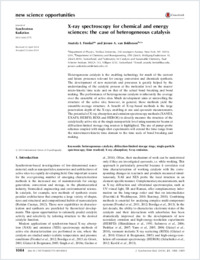X-ray spectroscopy for chemical and energy sciences: the case of heterogeneous catalysis.
- Frenkel AI Department of Physics, Yeshiva University, 245 Lexington Avenue, New York, NY 10016, USA.
- van Bokhoven JA Department of Chemistry and Bioengineering, ETH Zürich, Wolfgang-Paulistrasse 10, Zürich 8093, Switzerland.
- 2014-09-02
Published in:
- Journal of synchrotron radiation. - 2014
X-ray absorption
X-ray emission
diffraction-limited storage rings
heterogeneous catalysis
single-particle spectroscopy
time resolved
English
Heterogeneous catalysis is the enabling technology for much of the current and future processes relevant for energy conversion and chemicals synthesis. The development of new materials and processes is greatly helped by the understanding of the catalytic process at the molecular level on the macro/micro-kinetic time scale and on that of the actual bond breaking and bond making. The performance of heterogeneous catalysts is inherently the average over the ensemble of active sites. Much development aims at unravelling the structure of the active site; however, in general, these methods yield the ensemble-average structure. A benefit of X-ray-based methods is the large penetration depth of the X-rays, enabling in situ and operando measurements. The potential of X-ray absorption and emission spectroscopy methods (XANES, EXAFS, HERFD, RIXS and HEROS) to directly measure the structure of the catalytically active site at the single nanoparticle level using nanometer beams at diffraction-limited storage ring sources is highlighted. The use of pump-probe schemes coupled with single-shot experiments will extend the time range from the micro/macro-kinetic time domain to the time scale of bond breaking and making.
- Language
-
- English
- Open access status
- green
- Identifiers
-
- DOI 10.1107/S1600577514014854
- PMID 25177997
- Persistent URL
- https://folia.unifr.ch/global/documents/153434
Statistics
Document views: 7
File downloads:
- fulltext.pdf: 0
